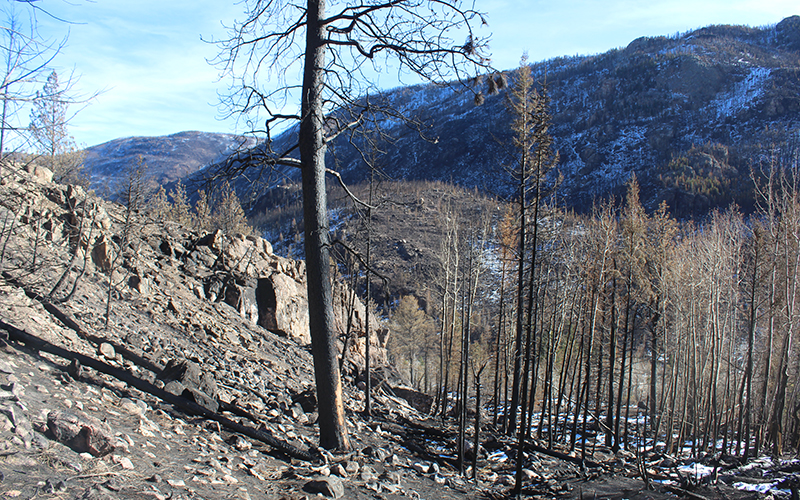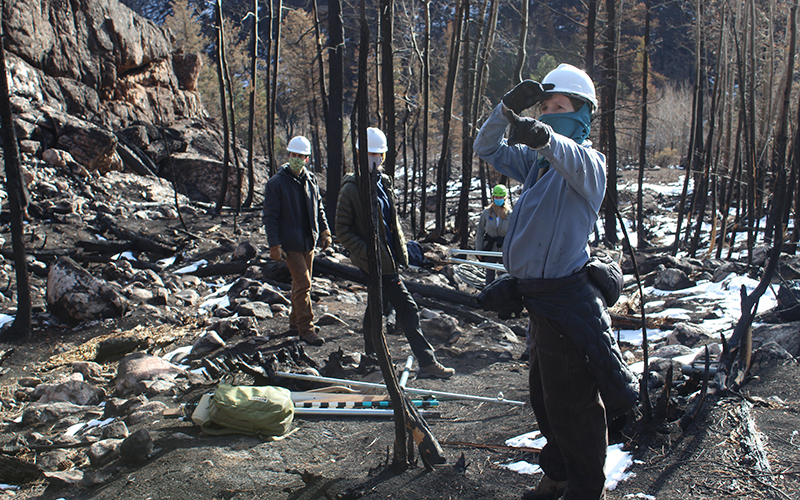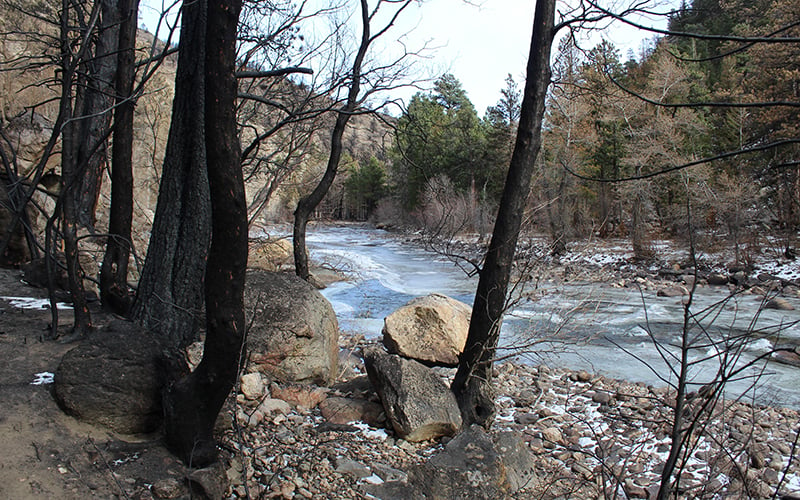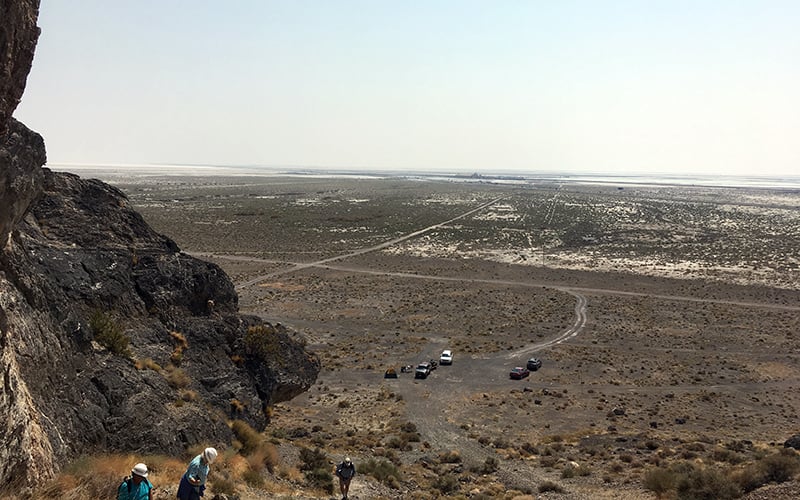GREELEY, Colorado – Record-breaking wildfires in 2020 turned huge swaths of Western forests into barren, sooty scars. Those forests store winter snowpack that millions of people downstream rely on for drinking and irrigation water. But with such large and wide-reaching fires, the science on the short-term and long-term effects to the region’s water supplies isn’t well understood.
To understand, and possibly predict, what happens after a river’s headwaters goes up in flames, researchers are descending on fresh burn scars across the West to gather data in the hopes of lessening some of the impacts on drinking water systems.
On a sunny winter morning, a team of researchers led by Colorado State University hydrologist Stephanie Kampf roamed through the steep drainage of Tunnel Creek, a tributary to the Poudre River west of Fort Collins. Much of the area burned last summer and fall during the Cameron Peak Fire.
Exploring a burn scar is like running an obstacle course. There are downed trees to climb over, duck under and trip over. There are the trees that are entirely burned, leaving gaping holes in the ground. Rubbing up against any charred bit of debris leaves clothes smeared with black smudges, as if the forest is trying to turn each person who enters into a living charcoal sketch.
High up in the creek’s drainage, near a frozen waterfall, Kampf paused ankle-deep in a burned out tree well.
“Wow, there’s so much ash there,” Kampf said. “That is so much ash!”
Even the tree’s roots have been incinerated.
For more than an hour and a half, Kampf’s team searched for a flat spot to construct a temporary weather station. Colorado State received a National Science Foundation grant to put instruments into the field quickly, before snows began to accumulate in the burned area. At more than 208,000 acres, the burn scar is the state’s largest on record.
Two other nearby fires also broke size records in 2020. In late October, the East Troublesome Fire exploded near the headwaters of the Colorado River, burning 193,812 acres, killing two people and prompting thousands to flee their homes. To the north, the Mullen Fire on the Colorado-Wyoming line topped out at 176,878 acres. Downstream on the Colorado River, the Grizzly Creek Fire torched 32,631 acres in and around Glenwood Canyon. And in the Book Cliffs north of Grand Junction, Colorado, the Pine Gulch Fire burned nearly 140,000 acres.
In the case of Cameron Peak, which acts as the headwaters for the wild and scenic Poudre River, Kampf and her colleagues want to know: What happens to the snow that falls on a burned area this large and this high in elevation?
“Some of these streams have burned so much, like the whole riparian zone is burned. And so there’s nothing alive at all,” Kampf said.
In the Western U.S., winter snow accumulation fills reservoirs, provides habitat for fish, birds and other wildlife, and eventually flows to bathroom faucets and irrigation canals from Denver to Tijuana, Mexico.
Existing research shows fires can affect snowpack in different ways. With fewer trees, and without their full, bushy branches, more snow tends to accumulate on the ground. Snow that’s caught in trees often blows off or turns immediately to vapor. So when a wildfire moves through a forest, scientists say to expect more snow to pile up on the ground.

The Cameron Peak Fire burned through the headwaters for northern Colorado’s Poudre River and many of its small tributaries. Much of the West’s water supply starts in such relatively small mountain areas. (Photo by Luke Runyon/KUNC)
But without a canopy of trees above it, the snow is more exposed to the sun, and in the spring, melting can become erratic. Midwinter melting can occur, which means a diminished runoff come spring.
These general findings can change, depending on the type of forest that burned, the direction the burned slope is facing and the severity of the burn in that area.
“We’re kind of in a brave new world when it comes to snow and wildfire,” said Anne Nolin, a geography professor at the University of Nevada, Reno.
Another side effect of fire, she said, is how it can change the composition of snow when it falls on the ground. It becomes darker, picking up charred bits of ash.
Studies of dust on snow have shown its dramatic effect on the timing of snowmelt. The same is true of snow that’s been mixed with charred debris and smoke particles, Nolin said.
“All that black gunk on the snow makes it melt a lot faster,” she said.
A mismatched timing of snowmelt makes the job of reservoir management much harder, Nolin said. Many water providers use long-term models to gauge when to release and store water. A burned drainage area makes those historical data less reliable.
Fires are an important part of forest ecology in the West, but Nolin said the fires in 2020 were unprecedented in their size and severity. Fires in California just over the state line from her home in Reno choked the air, burned homes and disrupted everyday life during an already stressful time.
“The scale that we’re experiencing now, we actually don’t know what the hydrologic impacts will be,” she said.
As researchers continue their work, said Gabrielle Boisrame, a researcher at the Desert Research Institute in Las Vegas, it becomes clear there is no “easy, straightforward answer.”
“If there’s a place that you haven’t already studied, you can’t say, ‘Aha, a fire has burned right here. I can tell you exactly what’s going to happen to the snowpack and the stream flow.’ There’s a lot of really complicated interactions happening,” Boisrame said.
With water supply margins already tight in many portions of the West, Boisrame said, water providers, agriculturalists and environmental groups are realizing “that we actually need to know” the detailed effects of how each individual burn scar will affect the water cycle.
That’s because no two fires are alike. Depending on weather and fuel loads, each fire burns a landscape with varying severity. And that severity matters, not just for forest recovery, but for water quality immediately following it, said Ben Livneh, a professor of engineering at the University of Colorado, Boulder.
“The most severe impacts actually come from moderate-severity fires,” Livneh said.
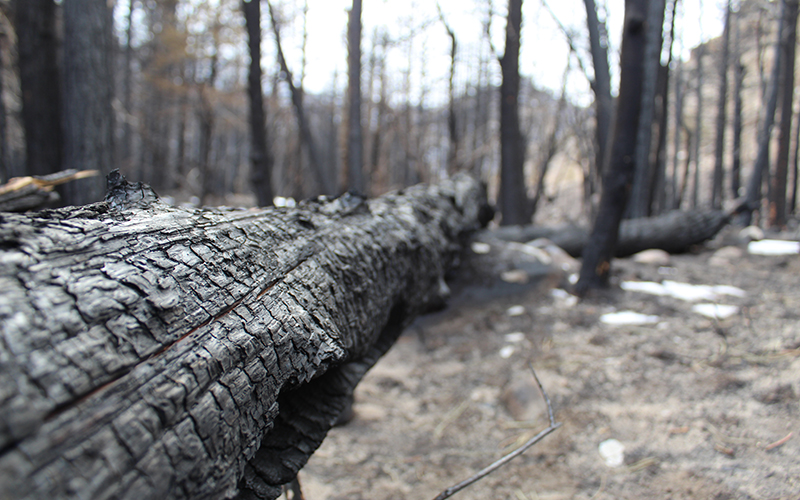
A charred tree trunk in the Cameron Peak burn scar in Poudre Canyon, Colorado. In fires with high severity burn, much of the vegetation is completely combusted, which can cause fewer problems than moderate fires that leave some vegetation standing. (Photo by Luke Runyon/KUNC)
In fires with high severity burn, much of the vegetation is completely combusted. Dissolved organic carbon can be one of the biggest headaches for water treatment facilities following a fire. Treating it can also result in byproducts found to be carcinogenic, Livneh said. But if there’s not much organic material left in a burned area – because it all burned – it doesn’t cause as many problems.
“And so maybe somewhat counterintuitively, the most severe fires aren’t necessarily the most damaging, at least from a water treatment and water quality perspective,” Livneh said.
Research has shown, too, that forest management can play a big role in lessening the impacts of fire on water systems. The Desert Research Institute looked closely at one creek watershed in Yosemite National Park where land managers have been more hands-off with fire suppression, allowing smaller fires to burn more frequently.
“They had fires that created this patchwork, where you opened up the forest more, and that led to getting more snow in those open areas, both in terms of the peak amount of snow accumulated and how long that snow stayed on the ground,” Boisrame said.
Small, prescribed burns that mimic more natural forest fires might be a way forward, she said.
“Do those kinds of fires lead to less sedimentation and less problems with flooding and water quality? It looks like they do,” she said.
One hurdle in understanding the relationship of burn scars and snowpack is that it’s a challenge to get good data from such dynamic environments. Landslides and floods after a fire can destroy scientific instruments.
That was top of mind for Kampf and her Colorado State colleagues as they examined the Cameron Peak burn scar. Finding a site for a weather station is like looking for a proper campsite. Researchers want something flat, on stable ground and free from large hazards, such as falling rocks and trees. That can be difficult to find in a recently burned forest.
The weather station along Tunnel Creek will be compared to another site untouched by fire. Other stations will look at impacts at higher and lower elevations. Kampf said they’re likely to collect data on soil moisture, solar radiation and precipitation for the next three to four years, although long-term funding hasn’t yet been secured.
It can be easy to think of wildfires as singular, acute events that displace people from their homes and fill the air with smoke until they are put out, Kampf said. But when it comes to snowpack and water supplies, the effects can last for decades. Much of the West’s water supply starts in relatively small mountain areas.
“When those areas get stressed by something like a whole series of severe wildfires,” she said, “then we’re talking about affecting the water supply of not just that area, but the water supply of entire huge river basins.”
This story is part of a project covering water in the western U.S. and the Colorado River Basin, produced by KUNC and supported through a Walton Family Foundation grant. KUNC is solely responsible for its editorial content.
